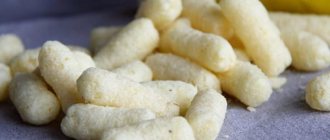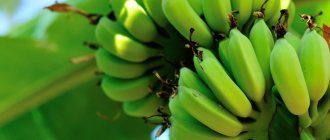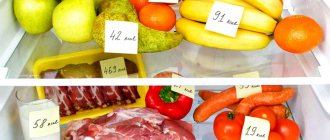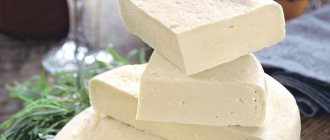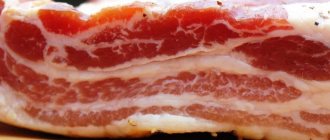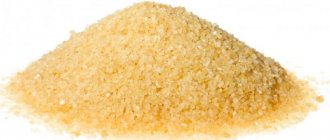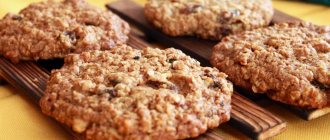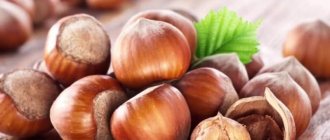Adyghe cheese is a soft brine cheese made from cow's milk. For its production, they do not use rennet (produced in the rennet glands of mammals), but a soft fermented milk starter. This makes the cheese accessible to vegans and vegetarians.
The taste and structure of the product are neutral, and therefore suitable for any dish. You can make a simple sandwich from bread and a piece of Adyghe cheese or add the product to soup, open/closed pie, salad, pizza, khachapuri, roll, puff pastry. The cheese is dense enough so as not to fall apart during rapid frying, but moderately soft so as not to spoil the structure of the baked goods.
The quality of dairy products is regulated by GOST, which strengthens the product’s position in the market. How to prepare Adyghe cheese and is it safe to include it in your daily diet?
General characteristics of the product
Content:
- General characteristics of the product
- Varieties of dairy product
- Chemical composition
- Use in cooking
- Features of industrial production
- How to make Adyghe cheese at home
- How to choose and store the product correctly
Adyghe or Circassian cheese is a national dish of the Circassian culinary tradition [1]. Its name was formed due to its territorial affiliation. The first industrial batches of cheese were produced in the Republic of Adygea by the Circassian population [2]. Cheese bars were made from whole goat or cow's milk. Later, as the industry became larger and more influential, producers switched to cow's milk to reduce the cost of production [3].
The product belongs to the category of soft cheeses without ripening. It has a muted sour milk taste, delicate texture and neutral aroma. There are only 2 variations of industrial dairy products: smoked and fresh. In the photo and even on store shelves, Adyghe cheese can easily be confused with mozzarella, feta cheese, ricotta, mascarpone or feta. But the main difference between the product produced by the Circassian people is pasteurization. The milk mixture is subjected to heat treatment, then fermented milk whey is introduced and the milk protein is allowed to precipitate. The external shape of the cheese is made primarily in the shape of a cylinder with convex side surfaces and rounded edges.
The taste of the product is clean, spicy, fermented milk. A sophisticated consumer will notice the specific taste of pasteurization and the subtle salty taste of whey protein. Its structure is moderately delicate, but not loose. The shade can vary from snow-white to light yellow. GOST allows individual cream spots on the surface of the bar and sections [4]. Adyghe cheese does not have a crust. Small slot-like voids and slight layering are allowed on the surface.
Useful properties of cheese from Adygea
The calorie content of Adyghe cheese made according to the classic recipe is 240 kcal per 100 g of product. In this recipe, fresh milk is curdled. Next, the curdled mass is placed in special molds to drain off excess whey moisture. The finished heads are packaged, and then it hits the shelves. The cheese prepared according to this recipe has a delicate consistency and a moderately salty sour-milk flavor.
During the smoking process, the calorie content is insignificant, but it increases due to an increase in the percentage of fat content. This species has an energy value of 275 kcal per 100 g. But the low calorie content is not the only value of this dietary product. Although there are some cautions regarding its use.
| pros | Minuses |
| The increased calcium content makes it especially useful in the diet of children and pregnant women, as well as those who dream of losing weight, since this microelement increases metabolism and helps in body shaping. | It is not advisable to consume this cheese only for those who are allergic to milk protein. |
| Adyghe improves the quality of the digestive process and has a beneficial effect on the nervous and hematopoietic systems. | Adyghe cheese should be consumed in limited quantities if you are prone to swelling, since it is stored in a concentrated saline solution. |
| In addition, it is very useful in the prevention of heart attacks, strokes and cancer. | You shouldn’t get carried away with it if you are prone to migraines. |
The product is valued for its composition, because it contains a lot of minerals (Ca, P, Na, K, S) and almost all vitamins.
Varieties of dairy product
Important: industrial Adyghe cheese can be found throughout the post-Soviet space. Recipes may differ in each country. Moreover, a similar product can be sold under different trade names [5]. Be careful before purchasing.
Homemade Adyghe cheese, unlike industrial cheese, can be found in 3 different variations: fresh, dried and smoked. Fresh is practically no different from what is sold on supermarket shelves. However, a homemade product may contain rennet. If its presence/absence plays an important role for you, then be sure to check the information with the seller.
Smoked Circassian cheese has several names: red, Armavir or Kabardian. The product has gained particular popularity in the western part of the North Caucasus. It is smoked for several days until the crust becomes dense and impenetrable to bacteria or air. The shelf life of smoked dairy products is 6 months.
Dried Adyghe cheese is very similar to local kurt (fermented milk cheese balls). Since ancient times, this product served as food for shepherds, warriors and hunters. Dried cheese is very salty and hard. It retains only 20% moisture and 2% salt. Locals dry the bars in the shade, after which they are poured into huge boxes, covered with a layer of grain and sent to a barn with a stable temperature and stable humidity. Its shelf life can reach several years.
Interesting: before use, the dried head is doused with boiling water or dipped in boiling water. The product instantly becomes soft and pliable, but its structure is still denser compared to classic Adyghe cheese.
Birth of a brand
The history of Adyghe cheese begins in the Republic of Adygea. That's why it's called that. The second name – “Circassian” – specifies that the local population (Circassians) considers it their national dish. Indigenous people produce this cheese not only for themselves, but also actively sell their own products.
There is even a festival competition dedicated to Adyghe cheese, which is held every year in Maykop by the Ministry of Agriculture. On this day, everyone can try real local cheese made by the keepers of the recipes, learn the intricacies of production, and also receive recommendations on what and how to eat it with.
The first appearance on the market can be dated back to 1980. It was in this year that the Dairy Industry magazine published the first laudatory article on the product.
At the same time, the industrial scale of production made it possible to begin mass sales and even send them to the Summer Olympic Games in special bright packaging, custom-made in Finland.
Chemical composition
Important: the product is prepared on the basis of pasteurized milk, whey and table salt. It is classified as a dietary food with high nutritional value and rich nutrient composition [6]. The mass fraction of fat in dry matter is 40%.
Nutritional value per 100 grams
| Calorie content [7] | 264 kcal |
| Squirrels | 19.8 g |
| Fats | 19.8 g |
| Carbohydrates | 1.5 g |
| Alimentary fiber | 0 g |
| Water | 56 g |
| Alcohol | 0 g |
| Cholesterol | 54 mg |
| Ash | 2.8 g |
Vitamin composition (in milligrams per 100 grams)
| Retinol (A) | 0,213 |
| Beta-carotene (A) | 0,1 |
| Tocopherol (E) | 0,3 |
| Ascorbic acid (C) | 0,2 |
| Thiamine (B1) | 0,04 |
| Riboflavin (B2) | 0,3 |
| Niacin (B3) | 0,3 |
| Nicotinic acid (PP) | 5,7 |
Concentration of minerals (in milligrams per 100 grams)
| Macronutrients | |
| Potassium (K) | 70 |
| Calcium (Ca) | 520 |
| Magnesium (Mg) | 25 |
| Sodium (Na) | 470 |
| Phosphorus (P) | 360 |
| Microelements | |
| Iron (Fe) | 0,6 |
Adyghe cheese: benefits and harm
Low calorie content and a rare ratio of nutrients determine the benefits of the product.
A morning sandwich with a tart piece will enrich your diet with essential substances, and if you regularly include the delicacy in your menu, you may notice improvements in your well-being.
- Due to lactic acid enzymes, the functioning of the gastrointestinal tract is stabilized. The intestines are populated with beneficial microflora, digestion and absorption of nutrients are improved, and harmful substances are cleansed.
- The calcium-phosphorus-fluorine triad has a beneficial effect on the condition of teeth, bones, hair, and prevents the development of osteoporosis and joint problems. To normalize mineral metabolism, it is enough to consume 50-100 grams of cheese per day.
- Potassium and magnesium normalize the functioning of the cardiovascular system, and zinc improves immunity and is involved in hematopoiesis. Rich mineralization in symbiosis with vitamins supports the reproductive system.
- Amino acids and a group of protein substances are in a bioavailable form. They are quickly and completely absorbed, providing the body with material for regenerating muscle tissue and replacing fat.
Be sure to read: Mozzarella cheese: fat content, composition, benefits and harm, number of calories per 100 grams
The fermented milk product supports protein-carbohydrate and fat metabolism, prevents dehydration, and therefore is included in the nutrition of athletes. It is useful for weakened people when recovering from illness or injury. Cheese dishes are recommended in the first half of the day, when food enzymes are most active.
The harm of Adyghe cheeses is a relative concept. Serious health complications are excluded (unless the cheese is missing), but there is no need to overeat. The Caucasian delicacy contains milk protein components that can cause allergies in children, pregnant women, and the elderly. Hypertensive patients will also have to limit their consumption of the product due to the large amount of spicy substances and salt.
Note . In 2009, Adyghe cheese received a geographical reference. Only a product produced on the territory of the Republic of Adygea is considered branded cheese. No matter how good cheeses from other regions are, they are all formally recognized as counterfeit.
Use in cooking
Adyghe cheese is eaten as an independent snack or added to the following dishes:
- vegetable salads;
- rolls;
- pizza, khachapuri;
- soups;
- vareniki;
- cheese masses;
- pies and pies;
- cheese sauces;
- wrapped in puff pastry, lavash.
Fried cheese is especially popular. The structure of the product allows it to be subjected to all types of heat treatment. It can be fried in a regular frying pan or on the grill to give it a specific smoky flavor. Fry the cheese in a drop of vegetable oil for 1 minute on each side until a thick crust forms.
Fresh Adyghe cheese can replace suluguni, mozzarella and other types of soft dairy products [8]. Dried, it is best to grate into pasta, scrambled eggs or salad. You can prepare dried Circassian bars at home: leave the fresh product unpacked in the refrigerator, covering the surface with a linen napkin. In a month, dried Adyghe cheese will be ready.
Delicious recipes with Adyghe cheese
- Fried Adyghe cheese. How to fry Adyghe cheese? Dip the finished cheese into the batter and fry on both sides over low heat in a frying pan. Recipe for making batter: beat 2 chicken eggs with a small amount of milk and 2 tbsp. spoons of flour, salt.
- Baked Adyghe cheese. Baked Adyghe cheese harmonizes perfectly with vegetables. Cut the cheese into slices, place chopped or grated vegetables (carrots, zucchini, potatoes, etc.) on it, add salt, coat with mayonnaise and sprinkle with grated hard cheese. Place the dish in the oven for 15 minutes.
- Salad with Adyghe cheese. The main basis of the salad is diced Adyghe cheese, boiled chicken breast, 2 boiled chicken eggs, and corn are added to it. A mixture of sour cream and mayonnaise is ideal as a dressing.
- Salad with Adyghe cheese and tomatoes. This salad is ideal for healthy food lovers. Add sliced tomatoes, cucumbers and diced sweet peppers to the diced pieces of Adyghe cheese. Olive oil would be better for dressing.
- Dumplings with Adyghe cheese. Knead the dough using water, eggs, vegetable oil, salt and flour. Filling: grated Adyghe cheese, greens. Form small cakes from the prepared dough, fill them with the prepared filling, pinch the edges and boil in boiling water. We determine the readiness of the dish by the floating of the dumplings. Before serving, brush the dumplings with butter and serve with sour cream.
Features of industrial production
Interesting: cheese became a brand in 1980. It was during this period that its industrial production began. Since then, a cheese festival has been held annually in the city of Maykop (Republic of Adygea). During the holiday, locals organize themed fairs, dress up in ethnic outfits, and prepare many varieties of cheese.
How is the product prepared [9]? The milk mixture is heated to 95°C, after which fermented milk whey is introduced. Once the whey has curdled, the milk curds are collected in willow baskets. These baskets leave a beautiful, recognizable pattern on the sides of the Adyghe cheese. The head is formed in the same basket. This manufacturing method allows you to preserve the nutritional properties of the product and additionally disinfects it. The output is low cheese cylinders. Their weight does not exceed 2 kilograms. Their surface is convex and the edges are rounded. The ideal cylinder is stable and elastic when pressed, and the inside is tender and soft. The aroma of the product is very reminiscent of baked milk with a subtle sour taste.
Important: the price of the finished product may vary depending on the quality of the raw materials and the authority of the manufacturer [10]. The average market value is $6-10/1 kilogram.
Production technology
In the past, sheep and goat milk were more often used to make cheese, but the specific smell of the products and their increased fat content make the final product less popular in the 21st century. In the era of popularization of a healthy lifestyle, consumers prefer low-fat foods in their diet. This is one of the reasons for the increased use of cow's milk in cheese production.
One of the main differences is pasteurization at higher temperatures (95°C). Fermented milk whey is gradually introduced into the milk, brought to the desired temperature (about 30 minutes), for further coagulation. Nowadays, factories more often use Bulgarian bacillus, used in the production of yoghurts. It ensures faster ripening of the product.
After about 5 minutes, clots of milk flakes will form on the surface. Previously, they were placed in wicker baskets made of willow twigs, forming beautiful lace patterns. Nowadays they use special forms similar to a colander. For example, the shape of the 33901 series completely imitates traditional baskets and gives a clear, recognizable pattern.
When all the whey has drained, turn the molds over and sprinkle the finished cheese with salt. This technology allows not only to disinfect the product, but also to preserve its best properties.
After drying and complete hardening, the cheese wheels are sent to the packaging workshop. Cut into four parts, they are packed into bags by hand. After pumping out the air and sealing it with a special device, labels are attached to the resulting bags of cheese, weighed and, after being put into boxes, sent to chain stores.
In addition to the classic Adyghe one, smoked one is also produced, which is in high demand. When produced at home, it is prepared in a smoker and hearth.
How to make Adyghe cheese at home
We will need:
- cow's milk - 2 liters;
- fermented milk product to taste (kefir/whey/yogurt) – 3 liters.
Best materials of the month
- Coronaviruses: SARS-CoV-2 (COVID-19)
- Antibiotics for the prevention and treatment of COVID-19: how effective are they?
- The most common "office" diseases
- Does vodka kill coronavirus?
- How to stay alive on our roads?
Preparation
Bring the milk to a boil, pour the fermented milk product into it and mix thoroughly several times. After some time, curd flakes will appear on the surface. As soon as this happens, turn off the heat. After a few minutes, the flakes will disappear and the serum will take on a clear or slightly greenish tint. Pour the finished mixture into a colander/sieve/special mold for making cheese. After 10 minutes, turn the mixture over and leave for 10-12 hours until the whey has completely drained.
The finished cheese can be salted or soaked in a solution of salt and spices, but this is optional. Brine solution recipe: 1 tablespoon whey + 3 tablespoons salt. Soak the cheese for 2-5 days, depending on the desired saltiness of the product. The aged mass must be placed in the refrigerator for 2-3 days, after which the snack is considered ready.
Vitamins in Adyghe cheese
Adyghe cheese contains the following vitamins: Mono- and disaccharides, PUFAs - Polyunsaturated fatty acids, Cholesterol, Ash, Water, Organic acids, Sodium, Potassium, Phosphorus, Magnesium, Calcium, Sulfur, Copper, Zinc, Iron.
| Vitamin | Meaning |
| Vitamin B1 (thiamine), mg | 0,04 |
| Vitamin B2 (riboflavin), mg | 0,3 |
| Vitamin B6 (pyridoxine), mg | 0,2 |
| Vitamin B9 (folic), mcg | 39 |
| Vitamin C, mg | 0,2 |
| Vitamin E (TE), mg | 0,3 |
| Vitamin PP (Niacin equivalent), mg | 5,7 |
| Vitamin B12 (cobalamins), mcg | 0,6 |
| Vitamin D, mcg | 0,64 |
| Vitamin A, mg | 0,205 |
| Vitamin A (VE), mcg | 222 |
| Beta-carotene, mg | 0,1 |
| Vitamin B5 (pantothenic), mg | 1,2 |
| Vitamin H (biotin), mcg | 4,2 |
Calorie content and chemical composition of other products
| Product | Kcal | Proteins, g | Fats, g | Angle, g | |
| American Cheese | 337 | 18,94 | 26,05 | 6,94 | |
| Provolone cheese | 351 | 25,58 | 26,62 | 2,14 | |
| Brie cheese | 334 | 20,75 | 27,68 | 0,45 | |
| Gouda cheese | 356 | 24,94 | 27,44 | 2,22 | |
| Gouda or Edam cheese | 357 | 24,98 | 27,69 | 1,67 | |
| Munster cheese | 368 | 23,41 | 30,04 | 1,12 | |
| Munster Cheese (Low Fat) | 274 | 24,7 | 17,6 | 3,5 | |
| Ricotta Cheese (Partly Skim Milk) | 138 | 11,39 | 7,91 | 5,14 | |
| Ricotta Cheese (Whole Milk) | 174 | 11,26 | 12,98 | 3,04 | |
| Chees Feta | 264 | 14,21 | 21,28 | 4,09 | |
| Cheese | 350 | 26,3 | 26,6 | ||
| Mascarpone cheese | 412 | 4,8 | 41,5 | 4,8 | |
| Russian cheese | 364 | 23,2 | 29,5 | ||
| Goat cheese | 290 | 21,3 | 21,7 | 0,7 | |
| Philadelphia cheese | 342 | 5,93 | 34,24 | 4,07 | |
| Ricotta cheese | 174 | 11,26 | 12,98 | 3,04 | |
| Adyghe cheese | 264 | 19,8 | 19,8 | 1,5 | |
| Dutch cheese | 350 | 26,6 | 26,6 | ||
| Camembert cheese | 324 | 15,3 | 28,8 | 0,1 | |
| Sulguni cheese | 286 | 20,5 | 22 | 0,4 | |
| Poshekhonsky cheese | 344 | 26 | 26,1 | ||
| Moscow cheese | 355,6 | 26 | 26,5 | 3,5 | |
| Altai cheese | 355,6 | 26 | 26,5 | 3,5 | |
| Green cheese | 355,6 | 26 | 26,5 | 3,5 | |
| Kostroma cheese | 343 | 25,6 | 26,1 | ||
| Lithuanian cheese | 250 | 27,9 | 14,7 | ||
| Latvian cheese | 316 | 23,3 | 24,1 | ||
| Ossetian cheese | 355,6 | 26 | 26,5 | 3,5 | |
| Baltic cheese | 207 | 29,8 | 9 | ||
| Soviet cheese | 385 | 24,4 | 31,1 | ||
| Estonian cheese | 355,6 | 26 | 26,5 | 3,5 | |
| Emmental cheese | 372,4 | 28,7 | 28,5 | 0,3 | |
| Pecorino cheese | 419 | 25,5 | 33 | ||
| Ukrainian cheese | 355,6 | 26 | 26,5 | 3,5 | |
| Uglich cheese | 347 | 25,8 | 26,3 | ||
| Yaroslavl cheese | 350 | 26,2 | 26,6 | ||
| Tofu cheese | 76 | 8,08 | 4,78 | 1,88 | |
| Green cheese pesto | 380 | 23 | 32 | ||
| Kurt cheese | 260 | 25 | 16 | 2,7 | |
| Cottage cheese | 317 | 7 | 31 | 2,5 | |
| Asiago cheese | 122 | 10,9 | 8,11 | 1,15 | |
| Fontina cheese | 389 | 25,6 | 31,14 | 1,55 | |
| Smoked cheese | 380 | 23,5 | 30,8 | ||
| Smoked cheese braid | 320 | 19,5 | 26 | 2,2 | |
| Cheese Buko | 200 | 8,5 | 17 | 3 | |
| Sausage cheese | 275 | 21,2 | 19,4 | 3,7 | |
| Mexican cheese | 282 | 24,69 | 19,4 | 3,41 | |
| Anari cheese | 195 | 11 | 15 | 2 | |
| Halloumi cheese | 255 | 25 | 16 | 2,6 | |
| Cheese Banon | 200 | 8,5 | 17 | 3 |
Long distance
We considered the option of an express diet for three days. But this is not the only weight loss system that uses Adyghe cheese. We have already reviewed the benefits and harms of this product, and now let’s look at a weight loss plan designed for 10 days.
Judging by the reviews, during this time you can lose up to 10 kg. The food is based on young cheese and vegetables. An excellent combination, it’s not for nothing that it is called the basis of health and longevity. If it is difficult to endure all ten days at once, then after five days you can take a break for two days. But at this time you cannot eat cereals, sweets and bread. You can eat up to 200 g of Adyghe cheese per day, it will not harm your figure. If you try to replace it with hard cheese, then the amount should be reduced to 50-70 g.
- The first day. In addition to cheese, you can afford a glass of milk, 2 fresh cucumbers, 4 tomatoes, 100 g of boiled meat per day.
- Second day. Two boiled potatoes, 5 radishes, 100 g of cabbage, a glass of milk and four boiled carrots.
- Boiled peas - 150 g, tea, 200 g asparagus, 30 g fermented milk drink, 2 cucumbers, 100 g boiled beans.
- Two bell peppers, a glass of milk, 100 g of boiled broccoli, 6 lettuce leaves, 100 g of boiled beef.
- Fifth day. A glass of kefir, two tomatoes, 200 g of eggplant stewed with garlic, 2 cucumbers, 100 g of boiled chicken, 50 g of celery root.
After a short break, the course can be repeated. Do not forget that feeling unwell is a reason to immediately stop the diet and consult a doctor.
Recommended Products
Let's look by brand to see what kind of cheese you can eat on a diet and proper nutrition:
✅Light cheese from . And also Edam from the same company does not contain harmful additives.
✅Cheese from Lambert “Tizilter” has a high fat content, but a few slices will not harm your figure.
✅ Cream cheese from “A Thousand Lakes” is also a little fatty, but in moderate quantities it will not harm.
✅ Fortunately, Edam cheese from Golden Europe . It has a high proportion of fat, but is quite safe for the body if consumed in moderation.
✅And Suluguni from Granabella . This product does not contain harmful additives.
What can be prepared from Adyghe cheese
The product is not only healthy, but also very tasty. You can simply eat it in its pure form. Some people prepare fried Circassian cheese or bake it. But they are limited to more than just this:
- making dumplings
- used for soups and any salads,
- suitable as a savory snack,
- as a filling for khachapuri or pies,
- create cheese sauce,
- as minced meat for meatloaf or for poultry meat,
- pasta, macaroni, porridge with cheese and other side dishes to taste.
In fact, it is a universal, healthy product that goes well with almost all dishes.
Not Recommended Products
Which cheese is not recommended to be added to your diet on a diet:
King of Cheeses from “Raw Foodists” will not work . Does not contain much toxic sodium nitrite.
❌ Unfortunately, Russian, Gouda and Dutch cheese from Savushkin . They also contain sodium nitrite.
❌And Light with Classic from “Brest-Litovsk”.
❌ Creamy/Classic/Traditional cheeses from Alantal are not suitable for diet.
❌It is also not advisable to add Light cheese from “A Thousand Lakes” to your diet.
Be careful when choosing loose cheeses. Study their composition carefully.
Now you know how to choose the right cheese on a diet. Take a closer look at the cheeses from the right list to make your diet tasty and healthy. You can also buy a product that you like, just study its composition first. Let your kilograms leave you at intergalactic speed.
Thanks for your time
Articles on the topic
One of the basic principles of Table No. 5, a diet followed by people with diseases of the liver, biliary tract and gall bladder, is a restriction in fats and cholesterol-containing foods. In the article “Top Ten Foods with Cholesterol,” I wrote that hard cheeses are high in protein, minerals, milk fat and cholesterol.
You obviously can’t eat a lot of this product, given that the daily fat intake is limited to 90 grams, 30 of which should be of plant origin. What should I do? Is it really possible to retire cheese from its position as the main morning product? First, try looking at a different shelf in the store. As an alternative to Gouda, Emmental, Dutch and other high-calorie cheeses, I offer dietary Adyghe, ricotta and feta.
Adyghe cheese: calorie content per 100 grams
Due to their moderate fat content, soft cheeses are not the most high-calorie foods. Thus, the energy value of 100 grams of Adyghe cheese is 254 kcal, which is 13-15% of the body’s daily needs. For weight loss diets, the plus is good: the human body is forced to use up internal fat reserves.
At the same time, in percentage terms, the daily intake of fat is satisfied by 44.7%, protein - by 23%. This balance balances the body's needs for building material for muscles and the energy value of the diet.
A few cooking secrets
Most dishes using suluguni are attractive due to their simplicity, nutritional value, and benefits. However, benefits can only be achieved if natural Abkhaz cheese is used to make various dishes. How to properly use suluguni at home? The secrets of this product are as follows:
- To prepare about 1 kg of cheese, you need to take about 10 liters of goat, cow, sheep, buffalo milk.
- The finished cheese is stored in a container, which is filled with brine, and then sent to the refrigerator. Under such storage conditions, Abkhazian suluguni cheese can be stored for approximately 1 month.
- Recipes that use suluguni cheese can be modified by supplementing them with different products with which this product is combined: chicken, fresh herbs, turkey meat, tomatoes, cucumbers, crackers.
- If you want to cook fried suluguni, then you can use not only breading, but also batter. In this case, the cheese turns out much more tender and softer.
- It is best to combine this delicacy with puff pastry, as the other makes the cheese very dry.
List of prohibited products
Any diet involves restriction, and protein diet is no exception. If the basis of your diet is cheese, then everything sweet and starchy is prohibited. Of course, this is a difficult test for most people, but the end justifies the means. You will also have to give up:
- Fried in oil.
- Fat.
- Salted and smoked.
- Semi-finished products.
- Carbonated drinks.
At the first stages, most vegetables and fruits are also prohibited. These are sources of carbohydrates that will only interfere with the effective breakdown of fat. But as the weight begins to decrease, you can gradually introduce cucumbers, cabbage, and grapefruits. Later you can afford tomatoes and apples. Last but not least, try to start eating potatoes and bananas. These are healthy foods, but you shouldn’t consume them during a diet, and then you need to stick to the norm.
